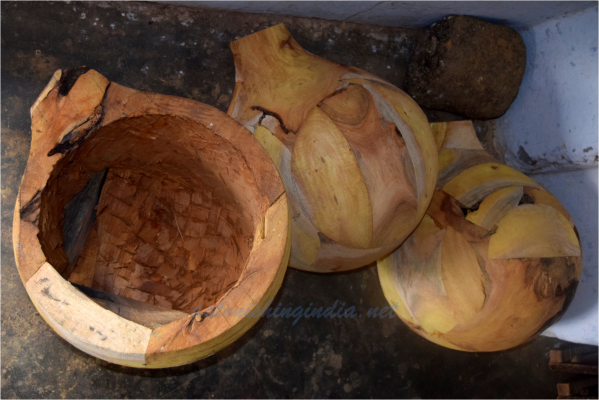Handcrafted Saraswati Veena Of Thanjavur
The Geographical Indication tag(formally granted in 2013) handcrafted Saraswati Veena of Thanjavur is revered by the Carnatic music stalwarts for its sonorous quality. A prized possession of the classical musicians, the artists go an extra mile to procure the original from the temple town.
I was in Thanjavur exploring the narrow bylanes when my guide Raja asked me if I wanted to visit Rajendran, a third generation Veena maker. As a teenager I had learnt to play Sitar and was always fascinated about the hollow bulb of the instrument. The child that I was, I assumed it was made from a hollow large pumpkin. And the misconception was busted only after I accompanied Raja.
History of Veena
Named after Goddess of wisdom, Saraswati, Veena is a stringed instrument for Hindustani classical music. The current form of the Veena is known as Raghunath Veena, named after King Raghunath Nayak of Nayak Dynasty of Thanjavur who ruled from 1600 to 1634. Not only the king patronized Carnatic music but himself was an excellent player of the instrument. He is credited with the invention of the raga Jayantsena.
The earliest recorded history of Veena dates to approximately 1700 BCE and finds mention in Atharvaveda.
Would you believe the twang of an archer’s bow inspired the string instrument?
A popular mythological story tells about the loud ear-shattering twang that shook Prithvi or the Earth, Swarg or the heavens and the Patal or underworld when Lord Rama strung the bow of Lord Shiva during Seeta’s swayamvara.
The sound from a warrior’s bow was known as ‘Jaya ghosh‘ or the declaration of victory. The sound thus produced by a taut string over wood may have given birth to the concept of producing music and hence the invention of stringed instruments.
In the mythological stories it is not only Saraswati who plays a veena but Narad muni and Ravana are also said to be excellent ‘vainik’, player of veena.
A skill of patience
The making of the instrument is indeed a skill of patience. A skilled maker of Veena can make or mar the sound that each instrument produces. Each Veena takes about two months to take final shape along with the intricate carving, final polishing, fretting and tuning.
The instrument is made from wood of mature jack-fruit tree. Pieces of wood are joined together to make bowl shape. It is then chiseled and hewn with a precision of sculptor to create a thin shell of wood. A wood arm is added to the bowl and the hollow covered with thin cover.

The initial bowls of jackfruit wood for Veena. this will be chiseled further till the shell is thin .
Sandpapered to a smooth finish overall, the sculptor starts to decorate the bulb of the instrument. From floral to mythological, all kinds of motifs find place on the bulb.
A second smaller bulb is fixed on the upper end of the arm which is mostly made of papier mache or fiber these days.

Veena instruments in various stages of making.
In the video below Rajendran, a third generation Veena maker chisels intricate details of Goddess Saraswati on the veena:
A dying art?
Even after GI tag, the makers of instrument have not gained much. A growing city means deforestation which leads to lesser availability of specific wood. That translates to increased expense for the artists involved in making of the Veena. However the veena maker hardly earns much after all the hard work.
Retailers sell each veena for 25000 to 35ooo Rupees but the maker gets maximum ten thousand.
With increased cost of living and cheaper machine made mass production of instruments the next generation is giving up the skill in crafting out the instrument by hand. About a handful of artists still carry on the tradition but they are a dwindling breed.
Need of the hour:
Before this heritage and ancient craft is lost to time, it is imperative that not only government extend a helping hand but also retailers should stop exploiting these artisans.
A buyer may insist on buying from the craftsmen instead of retailers.
Where to find these craftsmen?
These humble craftsmen can be found in small crowded houses at South Main street of Thanjavur where they create the perfect instrument.
I am no musician but the dedication that I saw in these craftsmen made me believe in hard work and power of music.



Beautiful
LikeLiked by 2 people
Thank you
LikeLike
Nice post on craftsmen of Thanjavur and history of Veena. Thanks for sharing 🙂
LikeLiked by 2 people
Thank you Varsha.
LikeLike
Interesting post 👍 Shoma. I liked the way you have written about the veena craftsmen and their importance. Thanks for sharing 🙂
LikeLiked by 2 people
Thank you Sachin. I am glad you liked it
LikeLike
Interesting read…will come back here again to understand it better’
LikeLike
Thank you. Would love if you visit again.
LikeLike
A saree story. My blog
https://chapter18.wordpress.com/2010/07/17/the-great-indian-stitch-less-garment/
LikeLike